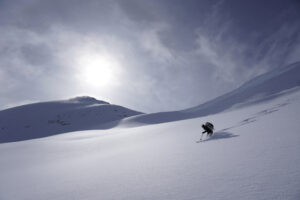
People & Culture
On thin ice: Who “owns” the Arctic?
As the climate heats up, so do talks over land ownership in the Arctic. What does Canadian Arctic Sovereignty look like as the ice melts?
- 4353 words
- 18 minutes
This article is over 5 years old and may contain outdated information.
History

Virtually since the moment that climate change entered public consciousness, melting northern ice has been used to illustrate its potentially catastrophic effects. A melting ice cap would raise sea levels, flooding major coastal cities such as Vancouver, New York and Rio de Janeiro, or even create a new ice age by cooling ocean temperatures and altering weather patterns.
Solid, peer-reviewed research has shown that polar ice has thinned and (depending on the summer) diminished significantly in overall coverage, but reports of its ultimate demise have been exaggerated in some media reports. Ice in the north is still a formidable force.
“2014 looks like the old days up here,” says Bill Noon, captain of the Canadian Coast Guard’s Sir Wilfrid Laurier icebreaker. “A lot of people think the ice is all gone, but it’s still around. A lot of it depends on which way the wind blows.”
Summer 2014 has been relatively cool in Canada’s Arctic, and with low winds in recent weeks, the breakup of the ice has been slow. The Canadian Ice Service has even speculated that the Victoria Strait — an intended target of this summer’s search for the lost ships of the Franklin Expedition, which is currently more than 90 percent ice covered — may not thaw at all, resulting in a multi-year ice pack not unlike that that sealed Franklin’s ships in their icy graves.
In years like, the subject of melting polar ice receives relatively little attention in international media. In years where ice coverage is light, much more has been made about its disappearance.
This pattern of media coverage could be contributing to a flood of poorly prepared northern voyagers plying Canadian waters, often at the expense of scientific research and Canadian tax payers. In recent years, Parks Canada’s search team has observed rowboats, jet skis and even a pontoon boat modified to look like a train attempting to traverse the Northwest Passage.
“We’ve also encountered a number of sailboats traversing the passage, and they generally seem to be well-prepared and very experienced,” says Parks Canada marine archaeologist Jonathan Moore, “but you wonder how some of the others vessels ever made it this far. The pontoon boat had made it all the way from Vancouver, and would have had to navigate some really nasty currents along the coast of B.C. and Alaska to get here.”
In addition to the obvious danger to human life, poorly prepared travelers strain the resources of Canada’s Coast Guard. The Sir Wilfrid Laurier is the nautical equivalent of a Swiss Army knife, equipped with a helicopter, zodiacs, small research vessels and even a hypothermic warming unit (hot tub). During the short open water season in the Arctic, the Sir Wilfrid Laurier maintains navigation markers on the Northwest Passage, hosts scientific researcher and performs search and rescue missions, which take priority over all else when they arise.
The 2013 jet-ski expedition — an ill-conceived plan to travel from Inuvik, Northwest Territories, all the way to England for an episode of a television show — inevitably ended in just such a mission. The Californian jet skiers didn’t come close to traversing the passage, much less the north Atlantic.
Diverting from its planned activities — which included serving as a base for Parks Canada underwater archaeologists searching for the lost ships of the Franklin Expedition — the Sir Wilfrid Laurier came to the rescue of the hapless television personalities, who they found huddled around a fire they’d lit at the centre of a circle of barrels of gasoline from their support boat, which they’d arranged as a windbreak on one of the Arctic Archipelago’s countless barren and windswept islands.
Fortunate not to have combusted themselves, the jet skiers and their gear were brought on board the Laurier. Their jet skis were promptly strapped to a barge and shipped back to California, while the jet skiers themselves were taken to the nearest community with an airport so they could find their own way home.
Are you passionate about Canadian geography?
You can support Canadian Geographic in 3 ways:

People & Culture
As the climate heats up, so do talks over land ownership in the Arctic. What does Canadian Arctic Sovereignty look like as the ice melts?

History
This year's search is about much more than underwater archaeology. The Victoria Strait Expedition will contribute to northern science and communities.

Exploration
An account of Enduring Ice, The Royal Canadian Geographical Society’s 2017 Expedition of the Year

Exploration
A behind-the-scenes look at the adventures and discoveries of the passionate explorers funded by the Royal Canadian Geographical Society